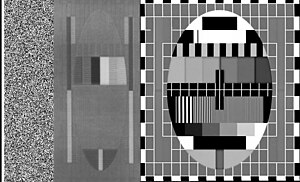C-MAC


C-MAC is the television technology variant approved by the European Broadcasting Union (EBU) for satellite transmissions.[1][2] The digital information is modulated using 2-4PSK (phase-shift keying), a variation of quadrature PSK where only two of the phaser angles (±90°) are used.[3]
- The data capacity for C-MAC is 3 Mbit/s.
- C-MAC data has to be sent to the transmitter separately from the vision.
- The transmitter switches between FM (vision) and PSK (sound/data) modulation during each television line period.
C-MAC variants : E-MAC[edit]
E-MAC (Extended MAC) is 16:9 version of C-MAC. Originally E-MAC was designed for 15:9 pictures, it later adopted the 16:9 aspect ratio.
- In E-MAC all the 4:3 information is transmitted exactly as in C-MAC so that C-MAC receivers are still compatible.
- E-MAC hides extra luminance and chrominance information in the field blanking interval and parts of the line blanking interval.
- E-MAC has a lower data capacity because luminance is hidden where data would usually be located.
- A 'steering' signal is transmitted to indicate to the 16:9 receiver whereabouts the 4:3 picture information.
- E-MAC receivers stitch the 4:3 and helper wide-screen data into a seamless 16:9 picture.
Technical details[edit]
MAC transmits luminance and chrominance data separately in time rather than separately in frequency (as other analog television formats do, such as composite video).
Audio and Scrambling (selective access)
- Audio, in a format similar to NICAM was transmitted digitally rather than as an FM sub-carrier.
- The MAC standard included a standard scrambling system, Euro-Crypt, a precursor to the standard DVB-CSA encryption system.
See also[edit]
TV transmission systems
References[edit]
- ^ RECOMMENDATION ITU-R BO.650-2 - Standards for conventional television systems for satellite broadcasting in the channels defined by Appendix 30 of the Radio Regulations (PDF). ITU. 1992. p. 5.
- ^ Buiting, J. (1990). "Introduction to Duobinary Encoding and Decoding" (PDF). Elektor Electronics. January 1990: 50–52.
- ^ Schlyter, Paul. "MAC (Multiplexed analogue components) in "Analog TV Broadcast Systems"".
